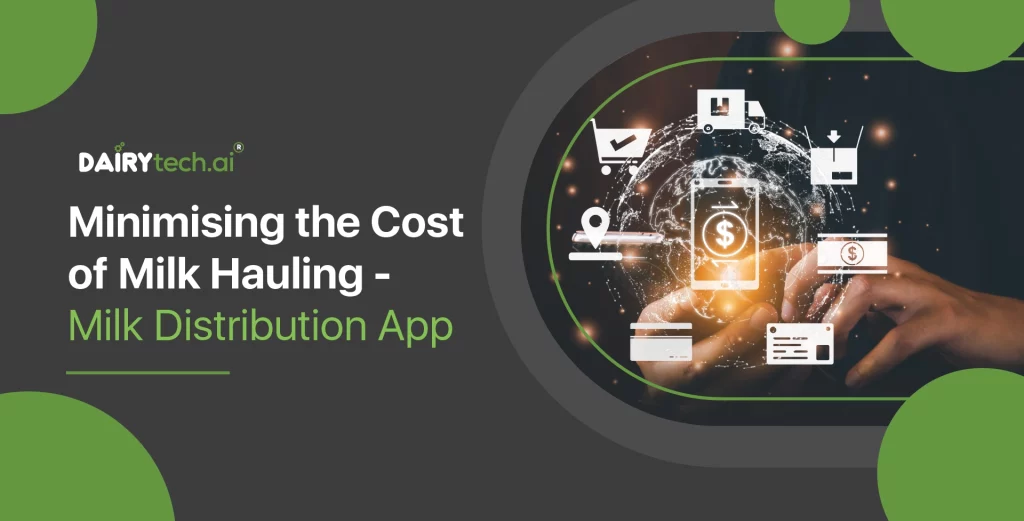Minimising the Cost of Milk Hauling – Milk Distribution App
The cost of milk hauling is one of the most significant expenses in the dairy industry, so adopting ways to minimise the cost of hauling with a milk distribution app will be crucial no matter how big or small the milk business is.
However, advancements in technology and logistics have allowed businesses to streamline and optimise the process of milk hauling to reduce costs.
In this blog, we’ll explore what milk hauling is, how it impacts milk businesses, and the strategies and tools that can help you minimise the cost of milk hauling.
What is milk hauling?
Milk hauling is the process of transporting milk from the dairy farm to the distribution centres or processing units. This process is crucial for B2B businesses that transport milk in bulk. Milk hauling is a much bigger expense for small businesses than it is for large businesses.
Impact of milk hauling costs on the business
Milk hauling can become an expensive expense if proper measures are not taken to manage the process.
Buying appropriate milk tanks for milk hauling is another crucial expense. Due to the importance of preventing milk spoilage, this expense cannot be avoided.
The distance between the farm and the distribution centre is an important factor on which the cost depends. The longer the distance, the greater the expense.
Distance impacts costs in the following ways;
- Milk has a very short shelf life, due to which it becomes important to provide an accurate environment while transporting the milk, which increases the cost of transportation.
- Greater distance also increases fuel consumption and driver expenses, as they will be spending more time on the road.
Logistics expenses can be minimised by the use of technology, unlike the expense of buying milk tankers.
Strategies for minimising the cost of milk hauling
Route optimisation
Route planning and optimisation are the cornerstones of a cost-effective and time-efficient milk hauling process. Route optimisation creates the shortest delivery path, which helps reduce both fuel consumption and labour costs. Integrating technologies like milk delivery software can help in efficient route planning, considering locations and traffic conditions.
These technological solutions like milk delivery management software use algorithms to calculate the shortest and most fuel-efficient path, ensuring timely deliveries. This not only saves fuel costs but also improves the speed of delivery, allowing drivers to deliver in less time. Optimising delivery routes can help reduce up to 6% of logistics costs, according to a study by Direct Science.
Other major benefits of route optimisation
- Having accurate and reliable delivery routes reduces the risk of accidents.
- Efficient route planning improves driver satisfaction and makes drivers feel less stressed.
- Timely-deliveries improve customer satisfaction and mitigate the chances of losing business partners or customers.
Real-time tracking with delivery app
Track your delivery vehicles from the business dashboard to identify roadblocks to efficient deliveries. Monitoring the vehicles using GPS allows for identifying the distance travelled and the time taken by the driver to deliver the milk by offering them a milk delivery app. The drivers are in direct communication with the dairy businesses. This proves the flexibility and transparency among delivery drivers and the milk business.
Adoption of technology helps in providing a holistic view of the milk supply chain, allowing them to make rational decisions in real-time.
Other benefits of milk delivery app
- Businesses can track and analyse the efficiency of deliveries and delivery drivers.
- Save time by auto-assigning the drivers and auto-scheduling the deliveries.
- The dairy business updates all entries made by the driver in real-time.
Additional strategies and tools that you can use to reduce costs
Loading and unloading
Minimising the time spent loading and unloading can help make milk hauling more efficient. Using tools like loading docks, pumps, and hoses makes it easier and faster to transfer milk from storage into the tanks.
Vehicle maintenance
Vehicles that are well-maintained run more efficiently, which makes regular maintenance important. More efficiency implies that the vehicle will use less fuel and have fewer breakdowns, resulting in less downtime and repair costs. Create a regular maintenance schedule with a checklist that includes regular oil changes, tyre rotations, and engine tune-ups. Monitor the delivery vehicle’s health.
Reduce empty-miles
Empty miles are the distance travelled by the milk-hauling vehicle without carrying a load, which can be a major expense. You can consider implementing backhauls or arranging partnerships with other businesses that require transportation in the same areas. Doing so, will prevent losses due to empty miles and improve efficiency and revenue.
Invest in fuel efficient vehicles
Fuel-efficient vehicles, like those with hybrid or electric technology, can be used. The one-time investment cost might seem high, but it can substantially reduce fuel costs over a period of time. The governments of certain regions also offer incentives or subsidiaries to businesses for adopting eco-friendly vehicles, which makes the investment more attractive.
Minimising the cost of milk hauling with milk delivery software is essential for dairy farmers and processing plants looking to improve their profitability. By implementing advanced technology, optimising routes, maintaining vehicles, monitoring operations in real-time, and investing in employee training, you can significantly reduce the expenses associated with milk hauling. These strategies not only save money but also enhance overall operational efficiency, ensuring that your milk reaches its destination in the best possible condition while maximising your bottom line. Book a call with our experts to discuss your dairy business and see how we can help.

